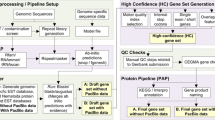Abstract.
During recent years, there has been an exponential rise in the number of sequences accessible in the public databases. Despite this, a high percentage of partial sequences of cDNA (ESTs) submitted to the databases remain unrecognized (anonymous ESTs). This lack of similarities could be explained by several hypotheses: i) a different part of the transcript is present in the GenBank; ii) the transcript represents a novel gene not yet isolated in other species; iii) alternative splicing of the same gene in different species; iv) inaccurate sequence data; and/or v) the sequence of the transcript has diverged to the extent that it is not recognized as an ortholog. In the present study we selected a sample of 20 ESTs from a pool of 656 anonymous pig small intestine ESTs in order to investigate the possible cause for the lack of similarities with database entries. To test the significant hypotheses we carried out total sequencing of each insert along with zoo-blot and Northern-blot analysis. Extended analyses of the 20 ESTs showed significant matches to seven existing database entries, whereas 13 still did not show significant hits. The results are discussed in the context of the hypothesis listed above.
Similar content being viewed by others
Author information
Authors and Affiliations
Additional information
Received: 7 October 1999 / Accepted: 27 March 2000
Rights and permissions
About this article
Cite this article
Cirera, S., Winterø, A. & Fredholm, M. Why do we still find anonymous ESTs?. Mammalian Genome 11, 689–693 (2000). https://doi.org/10.1007/s003350010127
Published:
Issue Date:
DOI: https://doi.org/10.1007/s003350010127




